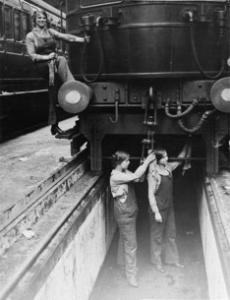WomensWork100
The First World War Centenary Partnership, led by the Imperial War Museum, is a network of over 3,800 not-for-profit organisations marking the First World War Centenary. In 2018 the FWWCP is presenting WomensWork100, a programme of events, exhibitions and activities that will explore the working lives of women during the First World War.
“WomensWork100 is an international programme of exhibitions, events, activities, film screenings, creative responses, personal stories and digital resources recognising and celebrating the working lives of women during the First World War and beyond.” #WomensWork100
Female carriage cleaners at London and South Western Railway
courtesy of the IWM, image no. Q109831.
The Centenary Partnership launched a new website ‘WomensWork100’ on 6th February, 2018. WomensWork100 is open to members of the First World War Centenary Partnership. Its aim is to encourage organisations to help tell the story of working women’s lives in the First World War. The project is also encouraging the use of the IWM Women’s Work Collection for members’ events and exhibitions – posters and photographs are available online. If you are not already a member of the partnership you will need to register to access the information and the website. Go to www.1914.org for details.
Members have been asked to share their stories about women’s work in WWI which will be available on the new website. Radcliffe on Trent WWI Group has been a member of the centenary partnership since 2014. We wrote a short piece about Radcliffe women and nursing for WomensWork100, which was published on their website on February 13th:
The Women of Radcliffe on Trent: Nursing in WWI
“Radcliffe on Trent WWI Group has been conducting research since 2014 on the impact of the Great War on the village. The following account provides a brief summary of local women’s war work as Red Cross workers.
The British Red Cross Notts 94 Detachment was set up in Radcliffe on Trent in 1913. The commandant was an American woman, Claire Birkin, who had married Lt. Colonel Birkin and lived at Lamcote House, the largest house in the village. Notts 94 VAD met in the school for training. As in all Detachments, the twenty-three members had to pass exams and obtain certificates before they were allowed to practice.
The women under Claire Birkin’s command were predominantly middle class. Their training in first aid, hygiene and nursing was soon put into practice when war was declared in 1914. Most began working in Trent Bridge Pavilion hospital and various Red Cross hospitals across Nottingham. Lamcote Auxiliary Hospital for Officers was set up in 1918 in Claire Birkin’s home and thirteen Notts 94 VADs were employed. The remaining Detachment members continued working elsewhere as nurses, clerical workers, linen store keepers and pantry maids.
Grace Durant, the most adventurous of the Notts 94 VADs, served in Malta. Her memoirs include a description of her time at St David’s Field Hospital:
The most serious cases on my line of tents had Black Water fever, a dreadful disease. In spite of blood transfusions quite a few died. In those days there were no blood banks to call on out there. When blood was required the bugle was sounded, the R.A.M.C. paraded and the volunteer accepted was placed in the next bed to the patient, the blood being transferred on the spot. We used to get tropical storms which lasted for about three days. Sometimes the tents would get blown away; the patients would take shelter in those that were left standing or in the cook house, which was the only building in the camp. It was quite a problem going round the various tents to find one’s patients.
Grace remained a nurse after the war and continued her career up to and including WWII.
Notts County War Hospital was located from July 1918 to August 1919 in the county asylum at Saxondale, Radcliffe on Trent. Civilian patients were dispersed to other institutions and the temporary military hospital was run by the war office. The hospital admitted 1189 servicemen suffering from war trauma. The IWM archives contain an interview from former nurse, Mrs Mary Jollie, who said of the men:
You saw a lot of stress and felt for their fears. They would sit round the fire in winter time and just sit there, not talk. They were easily moved to tears. Many of them feared going home because they’d been away a long time. It wasn’t a happy place.
Two Notts 94 VADs and a further six VADS from outside the county were employed as clerical workers, reflecting the growing employment of women nationally in the clerical sector.
To discover more about the war time work of women from Radcliffe on Trent go to www.radcliffeontrentww1.org.uk . The website includes detailed accounts of Claire Birkin’s work and Notts 94 VAD, the memoirs of Grace Durant and fifty biographies of local women”.

